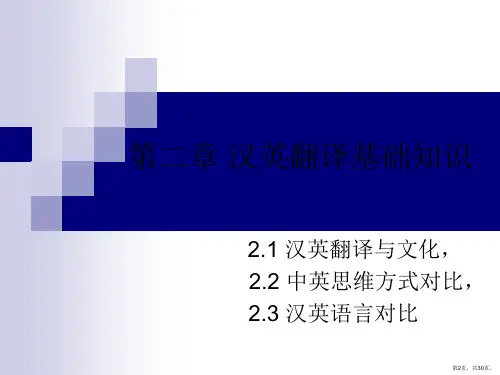第7讲 公示语和翻译中的文化 汉英翻译 教学课件
- 格式:ppt
- 大小:288.00 KB
- 文档页数:25

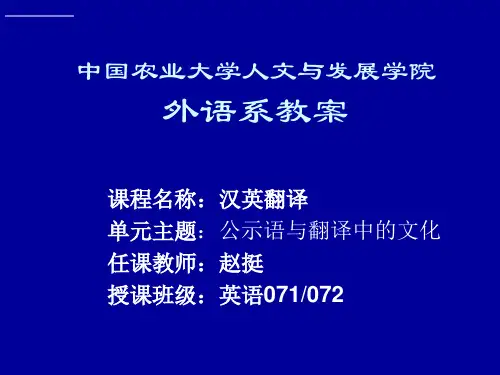
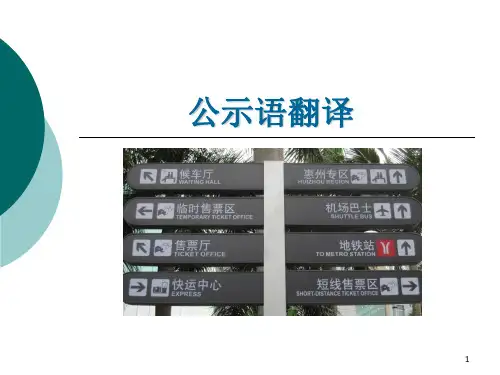
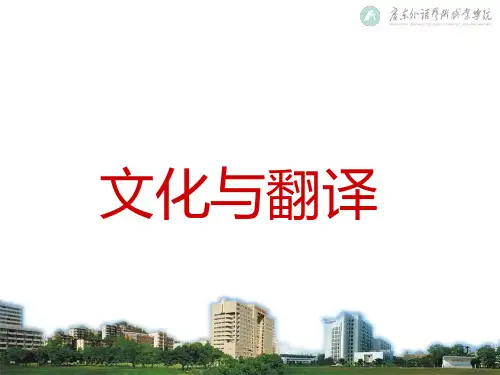
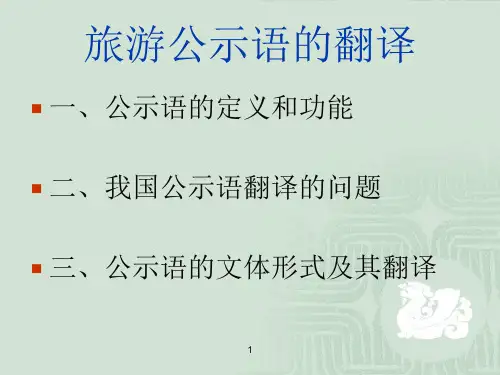


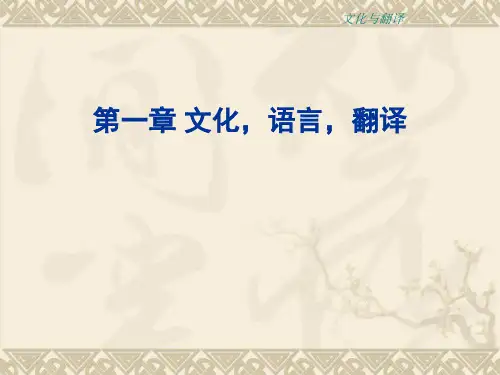
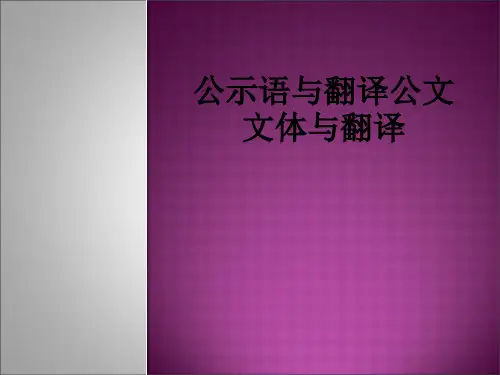
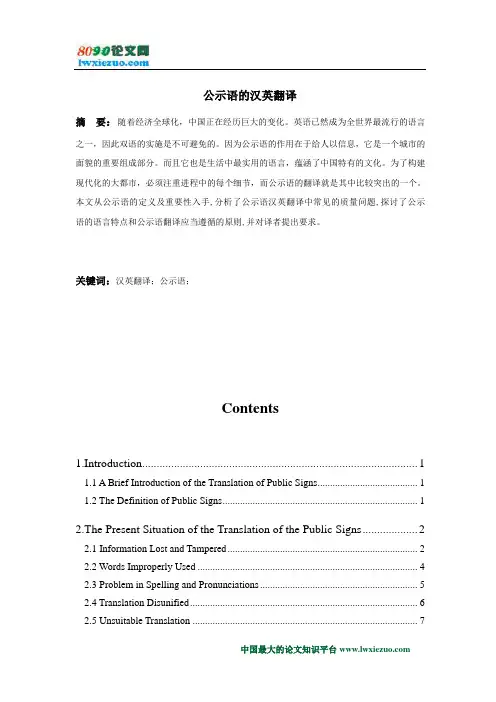
公示语的汉英翻译摘要:随着经济全球化,中国正在经历巨大的变化。
英语已然成为全世界最流行的语言之一,因此双语的实施是不可避免的。
因为公示语的作用在于给人以信息,它是一个城市的面貌的重要组成部分。
而且它也是生活中最实用的语言,蕴涵了中国特有的文化。
为了构建现代化的大都市,必须注重进程中的每个细节,而公示语的翻译就是其中比较突出的一个。
本文从公示语的定义及重要性入手,分析了公示语汉英翻译中常见的质量问题,探讨了公示语的语言特点和公示语翻译应当遵循的原则,并对译者提出要求。
关键词:汉英翻译;公示语;Contents1.Introduction (1)1.1 A Brief Introduction of the Translation of Public Signs (1)1.2 The Definition of Public Signs (1)2.The Present Situation of the Translation of the Public Signs (2)2.1 Information Lost and Tampered (2)2.2 Words Improperly Used (4)2.3 Problem in Spelling and Pronunciations (5)2.4 Translation Disunified (6)2.5 Unsuitable Translation (7)3.Methods to Assess the Quality of Translation of Public Signs (8)3.1 From the Aspect of the Applied and Indicated Function (8)3.1.1 Informational Function (8)3.1.2 Instructive Function (8)3.1.3 Regulatory Function (8)3.1.4 Warning Function (9)3.2 According to the Standard Issued by the State (10)3.3 Taking the Traditional Translation into Consideration (11)4.Methods Employed in Public Signs Translation (12)4.1 Literal Translation (12)4.2 Semantic Translation (13)4.3 Adaptation (14)5.Some Recommendations (15)6.Conclusion (17)1. Introduction1.1 A Brief Introduction of the Translation of Public SignsThe errors in C-E sign translation have drawn much attention of the public and the experts in this field. As a result, academic research and public campaigns on C-E sign translation are prevailing now. With the first national seminar on translation of public sings being held by the China Translation Association on the International Translation Day in 2005, the translation of public signs has been on the agenda of the construction of a modernization China. On the seminar, experts on the translation of public signs, points out that, the use of language in a country implicates the culture of that nation; on the process of constructing a harmonious society, all kinds of improper use of our mother tongue and foreign languages is inharmonic with that theme.A lot of errors were found and have been put into process, changed or unified, however, it is even until now—two years after the first nation seminar, the situation is not so positive. The translation of public signs is still far from perfect, even in world-famous metropolis as Beijing and Shanghai. This not only gives a negative impression on our foreign friends, but also is baneful to the development of our economy and culture and the gradually increase of foreign-oriented communication. 1.2 The Definition of Public SignsAccording to Oxford English Dictionary, sign refers to a characteristic device attached to, or placed infront of,an inn or a store,as a means of distinguishing it from others or direct attention to it.Public signs include marker, pointer, guide post, catchline, pronunciamento, warning and so on. Sometimes it is also called the environmental communication notices and signs (Ding Hengqi, 2006).The Chinese name of public places mainly refers to name of certain places and public places, such as public service establishments, public cultural and sports places, tourist scenic spots, national exhibitions and large activities, the office for the national department and so on (Xu Jian,2006) .While in English, there are many classifications for public signs and each of themwith a special name. For example, public signs in public buildings are called environmental communication signages, which mainly refer to the way-finding directional signs (Ding Hengqi, 2006). The signs in sight-seeing spots are certainly an important aspect of the public signs and they belong to environmental communication. The informational instructions on foods, medicine, cosmetics are also one kind of public signs, the instructional notices. English has a really long history for bilingual or multilingual public signs study, so it has been developed in a complete way, while in China, in such a short time, we can not make thorough development. The Chinese public signs are somehow different from their English counterparts and have their own characteristics.2. The Present Situation of the Translation of the Public SignsThough we have carried out the policy of reform and opening up to the outside world for many years, the history of bilingual public signs is of certain limitation. Some cities adopt the double language of public signs in the purpose of giving convenience and connecting China with the world. Each city has their own kinds of translation and then uses it in a rather proud way of being the first group of cities walking before the big tide of double-language.However, for various kinds of reasons, the status quo of the translation of the public signs is not so positive.As media takes part in, more versions of translations have come out, unfortunately without unification. While concerning this problem, it can be divided into several classifications as following:2.1 Information Lost and TamperedInformation lost and tampered is a big problem in the translation of public signs. To explain this category, some specific examples are illustrated. Please look at the following examples:Example A: “Passengers, stop here.”“Guests go no further.”“Guests, stop here.”“Tourists stop here.”From the translation of public signs above, as Chinese, we have no difficulty in guessing the meaning this sign wants to express originally. That is “Staff Only”(LuHefa & Shan Lipin, 2004) in English and “游客止步”in Chinese. All the text of the translation mentioned above is quoted from some tourist spots. It is no doubt that such series of translation will actually cause more or less misunderstanding and raise discussion. Many of them adopt the literal translation skills and put it in a rather stiff way. And one of the big problems is that it neglects the culture: this public signs already have their counterparts in English. As to such a matter, it is better to use the relative and idiomatic way to express it.Example B: “Shanghai Swimming Pool” , “Shanghai Swimming Center” and “Shanghai Swimming Gym”, which is better for the translation of “上海游泳馆”?“Pool” usually means:(1) a small and rather deep body of usually fresh water;(2) a quiet place in a stream;(3) a body of water forming above a dam (Webster’s Dictionary).“Center”here is given the meaning of a group of the same things that come together and combined to a big one.While gym is the abbreviation of gymnasium:(1) a large room used for various indoor sports (as basketball or boxing) andusually equipped with gymnastic apparatus;(2) a building (as on a college campus) containing space and equipment forvarious indoor sports activities and usually including spectator accommodations, locker and shower rooms, offices, classrooms, and a swimming pool (Websters’) .It seems that all these words can be combined with “swimming”, but the meaning is different. “Swimming pool”usually refers to one pool and it is used to describe those outdoor ones; while “swimming center” often takes up the center of that place and is the biggest one and sometimes even the unique one in that area. “Swimming gym”is comparatively common and it is more sports-oriented and always inside a building.As a matter of fact, the “上海游泳馆” contains more than one swimming pool andis a building with roof. It is also equipped with many training devices with the special training course carried out daily. Seen from the explanations mentioned above, the “上海游泳馆” actually should be translated into “Shanghai Swimming Gym”.This category of mistakes usually results in the misunderstanding or semi-understanding of the word and the culture of English. Like Chinese, English is full of synonyms. Though they are similar with each other in meaning, they are still different under certain circumstance, expressing the different meaning. Small differences should be paid great attention to, otherwise, mistake will occur and information be lost or tampered.2.2 Words Improperly UsedAll the translation context are translated by translators or interpreters, while their acquired English is of various levels, so the translation will no wonder fall into various category. The improper use of words is unavoidable. And we can see this kind of mistake in many places.The most common one is the translation of the residence of a community. In China, people tend to use “**花园,**新村,**村”to describe a residence of a group of people. For example, the translation of “美政花园”is “Meizheng Garden”on the guidepost along Fuxing Road in Hangzhou. Here “花园” indicates the place for living. But what is “Garden”to English-speakers? According to Merriam-Webster on line dictionary, the explanation is as following:(1)a: a plot of ground where herbs, fruits, flowers, or vegetables arecultivatedb: a rich well-cultivated regionc : a container (as a window box) planted with usually a variety of smallplants(2) a: a public recreation area or park usually ornamented with plants and treesb: an open-air eating or drinking placec: a large hall for public entertainment(Webster’s)To conclude, “Garden”is a place with plants and is created for relaxation and entertainment. So when English-speakers see the guidepost and go into the “garden”with the purpose of having some scenery to view or some relax, but only to find some tall buildings disappointedly and embarrassedly.Another example is the “市北新工业区”. The translation is “Shibei Industry New Zone”. When seeing this translation, we will wonder where “Shibei” is. It’s no doubt that this will cause a big laugh when we see the Chinese. Beside, this translation has another problem: the translation seems to be very coherence with the Chinese letter, even the order of the word. Actually it’s wrong. According to the usage of English word, the adjective “New” should be put above all other adjectives (Bao Bing, 2002). Therefore, the right translation should be “Shanghai Northern New Industry Zone”.2.3 Problem in Spelling and PronunciationsThe problem in spelling and pronunciation is very common in public sign translation. As we know, spelling and pronunciation is the most basic skills of English. But the translation of public signs in some places unfortunately manifests the qualification of the translator’s English. The spelling problem contains the mistake of followings:1) Wrong spelling“No smoking” and “No Park” is possibly due to the carelessness of the translator. The correct writing should be “ No Smoking” and “No Parking”.2) Capitalized wordsIn the display of place name, the capitalized words are used in a very common way. We can see every road on the guidepost begins with a capitalized letter. But unfortunately, many are wrongly written, especially on the screen of the public transportation in Shanghai. There’s a screen on every bus or subway that shows the name of the stop. And the mistake of capitalized mistake is unified in a surprising way—mistake all in one way, “South Hong Mei Road”, “Yan Chang Road”, “Gui Lin Newly State” and so on. According to the convention of translation of roads issued in 2005, name of roads should be written in a formal way, with the first letter of the proper noun(Xu Jian, 2006) capitalized and other using small letters. So the correct spelling should be “South Hongmei Road”, “Yanchang Road”and “Guilin Newly State” .3) PronunciationThe pronunciation of the transportation is newly appeared in the major cities of China. It is carried out to give convenience to English-speakers. But as a matter of fact, the pronunciations on buses or subways are not very clear, especially in Hangzhou, so it is not an easy work to understand them. Methods should be adopted to solve this problem.Besides, there’s another problem of pronunciation, using American English or British English. British English is standard English according to the history of English, however as centuries pass, American English now has become more popular and used more widely. So when announced in the bus or subway, the name of the bus stop should adopt which version of English is actually a difficult choice. .Further more, the pronunciation should be paid great attention to. In the Y5 bus in Hangzhou, it can be clearly noticed that the announcer pronounce the “r” as “l”. And intonation is a big problem as well.2.4 Translation DisunifiedThe disunification here refers to the translation of the same place or of the same place name in different way and the different translation of the same Chinese character with the same meaning.1) Same place name with different translation versionDifferent buses have different translation versions for the same bus stop, not even take that of the subway into consideration. For example, in Shanghai, there are many bus stops before “上海植物园”. While the author rides on different bus, two kinds of pronunciations are heard “Shanghai Botanic Garden”and “Shanghai A rboretum”. These two kinds of translation are all correct and suitable but there’s only one problem: the name place is unique when it refers to the specific ones. Try to imagine, if two foreigners talk about this place, one with the translation of “Shanghai Botanic Garden”, while the other uses another one. What an embarrassing situation it was.2) Same common noun with different translation versionHere the same common noun is the noun commonly used in place name, referring to things of the same kind and the special one of this kind, such as the “station”“airport” and so on (Xu Jian, 2006) . This kind of translation should be unified in the whole city, the whole country and even the world as a whole. While the author discover that this aspect of translation is really terrible to some extent. Take “新村” for example. In Hangzhou, the translation of “闸弄口新村”is “Zha Nong Kou Community ” but “田林新村” in Shanghai is “Tianlin Newly Estate”. “新村” is shown in the same characters and means the same in China, but why the translation of the two characters are totally different. This kind of translation should be put into unity and convention.3) Differences in writing and pronunciationThe author also discovers that some place are written in one way on the bus stop post and the digital screen in the bus, but announced in another way. For example, “田林十一村” in Shanghai is written “Tian Lin No.11 Newly State” while is broadcast in “11th Tianlin Newly State”. Though it is just a small problem and can be understood to some extent. Any way, this disunity should also be emphasized in the progress to contribute a perfect image of a civilized city.2.5 Unsuitable TranslationHere unsuitable translation refers to those that need translation are not translated and vice versa.Many public signs are not translated, like many public signs in the subway of Shanghai. Shanghai is a very common place for foreigners to go, visit or invest. And the subway is somehow a very important transportation means. “老,孕,病,残专座”should be translated out, “please offer this seat to elderly or disabled people or those carrying children”; “get off first” for “先下后上”; “get-on district” for “上客区” and “get-off district” for “下客区”.The expression of some public signs is very particular and exclusive in China. They illustrate the fascination or the dark aspect of China to which there’s no need to translate to show to our foreign counterparts (Luo Xuanmin & Li Tuwang, 2006). Take “No pee here” for an example. This public sign is embarrassed and only indicates the impoliteness of Chinese, which will leave a negative impression to those foreign visitors in the scenery spot. Therefore, it is better not to translate this kind of publicsigns.3. Methods to Assess the Quality of Translation of Public SignsThe author has pointed out several categories of mistake. So what is the standard the author takes to assess those translations? The standards are illustrated as the followings:3.1 From the Aspect of the Applied and Indicated FunctionAs the public signs is used in every aspect of our daily life and does direct impact on our life, the translation of public signs is based on the acknowledgement of the applied and indicated functions of them. The most important ones are informational function, instructive function, regulatory function and warning function (Stuart Redman, 2002). The different functions of the public signs directly affect the style and the mood of the translation.3.1.1 Informational FunctionInformational function refers to the service of the information, without any limited or compellent meaning. It is to provide some information to better the service towards the aimed group of people. Its function is to indicate the context of the service, for example: “Information”for “问询”, “Car Rental ” for “租车”, “Travel Service”for “旅游服务” and “Take away” for “外卖”。
